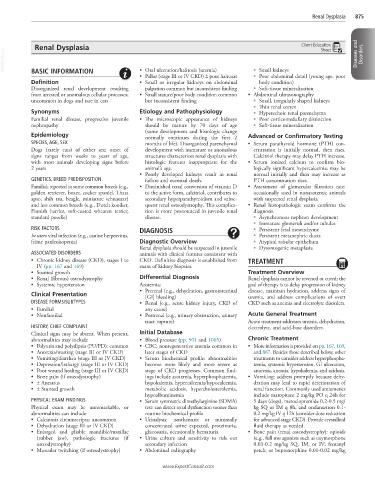Page 1742 - Cote clinical veterinary advisor dogs and cats 4th
P. 1742
Renal Dysplasia 875
Renal Dysplasia Client Education
Sheet
VetBooks.ir Diseases and Disorders
• Oral ulceration/halitosis (uremia)
BASIC INFORMATION
○ Poor abdominal detail (young age, poor
• Pallor (stage III or IV CKD) ± poor haircoat ○ Small kidneys
Definition • Small or irregular kidneys on abdominal body condition)
Disorganized renal development resulting palpation common but inconsistent finding ○ Soft-tissue mineralization
from arrested or anomalous cellular processes; • Small stature/poor body condition common • Abdominal ultrasonography
uncommon in dogs and rare in cats but inconsistent finding ○ Small, irregularly shaped kidneys
○ Thin renal cortex
Synonyms Etiology and Pathophysiology ○ Hyperechoic renal parenchyma
Familial renal disease, progressive juvenile • The microscopic appearance of kidneys ○ Poor corticomedullary distinction
nephropathy should be mature by 70 days of age ○ Soft-tissue mineralization
(some development and histologic change
Epidemiology normally continues during the first 2 Advanced or Confirmatory Testing
SPECIES, AGE, SEX months of life). Disorganized parenchymal • Serum parathyroid hormone (PTH) con-
Dogs (rarely cats) of either sex; onset of development with immature or anomalous centration is initially normal, then rises.
signs ranges from weeks to years of age, structures characterizes renal dysplasia with Calcitriol therapy may delay PTH increase.
with most animals developing signs before histologic features inappropriate for the • Serum ionized calcium to confirm bio-
2 years animal’s age. logically significant hypercalcemia: may be
• Poorly developed kidneys result in renal normal initially and then may increase as
GENETICS, BREED PREDISPOSITION failure and eventual death. PTH concentration rises.
Familial; reported in some common breeds (e.g., • Diminished renal conversion of vitamin D • Assessment of glomerular filtration rate:
golden retriever, boxer, cocker spaniel, Lhasa to the active form, calcitriol, contributes to occasionally used in nonazotemic animals
apso, shih tzu, beagle, miniature schnauzer) secondary hyperparathyroidism and subse- with suspected renal dysplasia
and less common breeds (e.g., Dutch kooiker, quent renal osteodystrophy. This complica- • Renal histopathologic exam confirms the
Finnish harrier, soft-coated wheaten terrier, tion is more pronounced in juvenile renal diagnosis.
standard poodle) disease. ○ Asynchronous nephron development
○ Immature glomeruli and/or tubules
RISK FACTORS DIAGNOSIS ○ Persistent fetal mesenchyme
In utero viral infection (e.g., canine herpesvirus, ○ Persistent metanephric ducts
feline panleukopenia) Diagnostic Overview ○ Atypical tubular epithelium
Renal dysplasia should be suspected in juvenile ○ Dysontogenic metaplasia
ASSOCIATED DISORDERS animals with clinical features consistent with
• Chronic kidney disease (CKD), stages I to CKD. Definitive diagnosis is established from TREATMENT
IV (pp. 167 and 169) exam of kidney biopsies.
• Stunted growth Treatment Overview
• Renal (fibrous) osteodystrophy Differential Diagnosis Renal dysplasia cannot be reversed or cured; the
• Systemic hypertension Azotemia: goal of therapy is to delay progression of kidney
• Prerenal (e.g., dehydration, gastrointestinal disease, maintain hydration, address signs of
Clinical Presentation [GI] bleeding) uremia, and address complications of overt
DISEASE FORMS/SUBTYPES • Renal (e.g., acute kidney injury, CKD of CKD such as anemia and electrolyte disorders.
• Familial any cause)
• Nonfamilial • Postrenal (e.g., urinary obstruction, urinary Acute General Treatment
tract rupture) Acute treatment addresses uremia, dehydration,
HISTORY, CHIEF COMPLAINT electrolyte, and acid-base disorders.
Clinical signs may be absent. When present, Initial Database
abnormalities may include • Blood pressure (pp. 501 and 1065) Chronic Treatment
• Polyuria and polydipsia (PU/PD): common • CBC: nonregenerative anemia common in • More information is provided on pp. 167, 169,
• Anorexia/wasting (stage III or IV CKD) later stages of CKD and 887. Besides those described below, other
• Vomiting/diarrhea (stage III or IV CKD) • Serum biochemical profile: abnormalities treatments to consider address hyperphospha-
• Depression/lethargy (stage III or IV CKD) become more likely and more severe as temia, systemic hypertension, GI ulceration,
• Poor wound healing (stage III or IV CKD) stage of CKD progresses. Common find- anorexia, anemia, hypokalemia, and acidosis.
• Bone pain (if osteodystrophy) ings include azotemia, hyperphosphatemia, • Vomiting: address promptly because dehy-
• ± Anestrus hypokalemia, hypercalcemia/hypocalcemia, dration may lead to rapid deterioration of
• ± Stunted growth metabolic acidosis, hypercholesterolemia, renal function. Commonly used antiemetics
hypoalbuminemia include maropitant 2 mg/kg PO q 24h for
PHYSICAL EXAM FINDINGS • Serum symmetric dimethylarginine (SDMA) 5 days (dogs), metoclopramide 0.2-0.5 mg/
Physical exam may be unremarkable, or test: can detect renal dysfunction sooner than kg SQ or IM q 8h, and ondansetron 0.1-
abnormalities can include routine biochemical profile 0.2 mg/kg IV q 12h (consider dose reduction
• Calcinosis circumscripta: uncommon • Urinalysis: isosthenuric or minimally for advanced stage CKD). Provide crystalloid
• Dehydration (stage III or IV CKD) concentrated urine expected, proteinuria, fluid therapy as needed.
• Enlarged and pliable mandible/maxillae glucosuria, occasionally hematuria • Bone pain (renal osteodystrophy): opioids
(rubber jaw), pathologic fractures (if • Urine culture and sensitivity to rule out (e.g., full mu agonists such as oxymorphone
osteodystrophy) secondary infection 0.03-0.2 mg/kg SQ, IM, or IV; fentanyl
• Muscular twitching (if osteodystrophy) • Abdominal radiography patch; or buprenorphine 0.01-0.02 mg/kg
www.ExpertConsult.com

